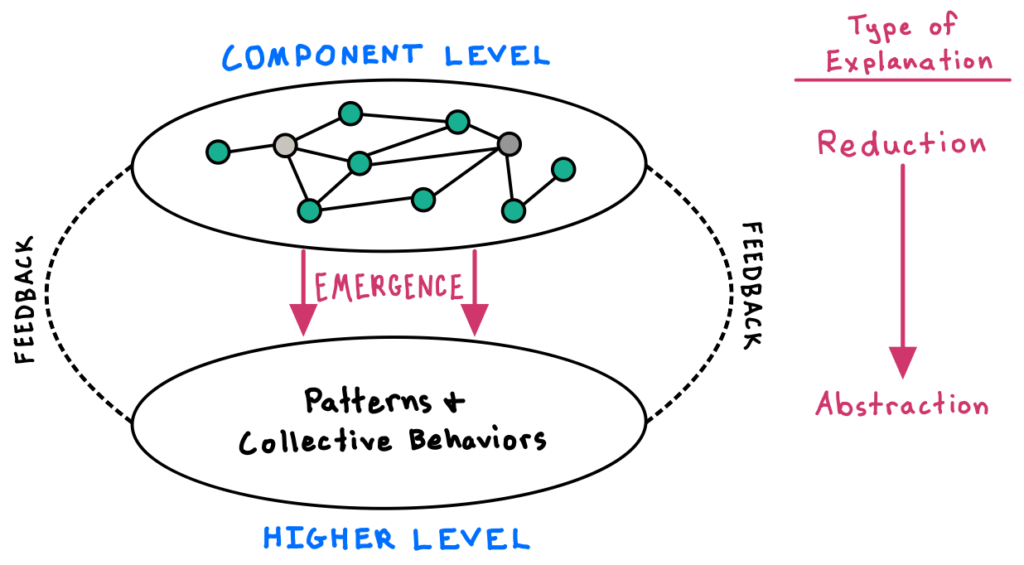“We can’t control systems or figure them out. But we can dance with them!”
Donella Meadows, Thinking in Systems (2008, pg. 170)
In complex systems such as human beings, companies, or ecosystems, collective behaviors can create dynamics that cannot be defined or explained by studying the parts on their own. These “emergent” behaviors result from the interactions between the lower-level components of a system and the feedback loops between them.
For example, in our brains, groups of neurons exchanging disordered electrical signals create incredible phenomena, such as senses and memory. Collections of employees swapping information and favors within a company can create factions and hidden bargains. In nature, examples of emergent collective behaviors are everywhere, such as birds flocking, hurricanes or sand dunes forming, social network development, the evolution of life, climate change, the formation of galaxies and stars and planets, and the development of consciousness in an infant.
In all of these examples, the system is not only more than the sum of its parts, it is also very different from those parts. We cannot analyze a single skin cell and infer someone’s personality. Nor can we analyze one employee and infer the behavior of the organization.
If we aspire to operate effectively in complex systems, we cannot afford to underestimate the possibility and power of emergent phenomena. The complex ongoing interactions between system components will cause unique and unexpected behaviors. Developing a better understanding of emergence can not only help us prepare to be unprepared, but also to create truly unique explanations and solutions.
Emergent explanations
Imagine how difficult it would be if we could only learn reductively—that is, by analyzing things into their constituent parts, such as atoms. Even the most basic, everyday events would be overwhelmingly complex. For example, if we put a pot of water over a hot stove, all the world’s supercomputers working for millions of years could not accurately compute what each individual water molecule will do.
With emergent phenomena, however, high-level simplicity “emerges” from low-level complexity. As a result, we may be able to understand systems extremely well and make useful predictions by analyzing phenomena abstractly—that is, at a higher (emergent) level. In fact, as theoretical physicist David Deutsch explains, all knowledge-creation actually depends on emergent phenomena—problems that become explicable when analyzed at a higher level of abstraction.1

Consider thermodynamics, the physical laws governing the behavior of heat and energy. These powerful and fundamental laws do not attempt to describe the world in terms of particles or atoms. They are abstract, describing physical phenomena in terms of their higher-level properties, such as temperature and pressure.
Thermodynamics can help us understand why water turns into ice at low temperatures and gas at high temperatures, without requiring us to analyze the details of each individual water molecule. It is due to the emergent phenomena of phase transitions, sudden transformations that occur when one or more control parameters of a collective system cross a critical threshold. At certain temperatures, the water will freeze, melt, or vaporize.2
Merely analyzing individual water molecules would not enable us to simply “deduce” how these phase transitions happen—or indeed whether they would occur at all. Phase transitions are emergent phenomena.

The emergent (crypto) economy
The economy is an intricate web of behaviors and relationships, emerging from the actions of diverse agents—individuals, companies, investors, regulators—each concurrently pursuing their own goals. These agents are not merely “participants” in the economy; they co-create its dynamics. A great example is the emergence of cryptocurrency markets such as bitcoin.
Imagine a small group of techies that starts investing in bitcoin, driven by a belief that its price will rise in the future. If bitcoin’s value indeed rises, news will spread, potentially igniting a viral wave of speculation. The influx is not just about making money, but also about joining a movement. Stories of newly minted millionaires fuel additional speculation and even attract criminals and fraudsters seeking to exploit the frenzy. Concerned regulators may institute game-changing rules to quell the madness.
Here, thousands of decisions by diverse individuals converge to create a market behavior that is far different than the sum of its parts: a bubble—which is clearly not in the collective interest. Characterized by speculation and volatility, the bubble is a cycle of elation and fear, gains and losses, that transcends individual intentions.
We observe such emergent economic phenomena not only in cryptocurrencies, but also in stock market oscillations, housing bubbles, and even the rise and fall of entire economies. In these systems, predictability is an illusion and periods of stability are tentative, as economic agents constantly respond to and anticipate changes in the dynamic landscape they themselves help shape.3
Managing emergent behavior in economics requires an understanding that plausible-sounding approaches might fail—or backfire entirely.
Dancing with fire
In economics as well as nature, emergent behavior can cause rapid change, and managing it may require counterintuitive interventions.
Consider forest fires. The destructiveness of forest fires follows a power-law distribution, in which there are many small fires that are generally manageable or tolerable, and a few massive, catastrophic fires.
Until 1972, Yellowstone Park rangers were required to extinguish every small fire immediately—a policy that made sense when analyzed reductively (“We should save every tree.”). But this policy led Yellowstone to grow dense with old trees, making a mega-fire like the one in 1988 inevitable. The reductive policy ignored the emergent phenomena of phase transitions: as a forest approaches critical thresholds of tree density and tree age, the potential for a massive fire grows exponentially. Today, most forestry services utilize a “controlled-burn” policy of intentionally sparking smaller fires under careful watch, reducing the potential for a massive fire.4
We must be aware when the potential for emergent behavior exists—that is, any time we are engaged with complex systems. Our focus should not be on trying to perfectly predict the future (which invites us into traps of overconfidence and illusions of control), but rather on being adaptable, to ensure we’re prepared to respond to the unexpected.
***
Systems such as the economy, democracy, science, and forests emerged through centuries of iteration and adaptation. The most complex systems emerge and function without anyone having knowledge of the whole.5
Consequently, we should be skeptical about the potential efficacy of simplistic policies and predictions targeted at complex systems. It is impossible to perfectly anticipate the system’s behavior. What we can do is diligently attempt to observe a system’s dynamics, map out its feedback loops, identify and intervene at key leverage points, and be prepared to learn and adapt as emergent behavior unfolds.

